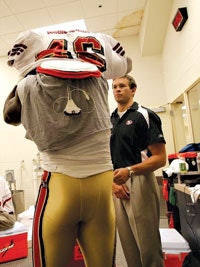The San Franscisco 49ers are helping researchers learn more about the biomechanics of football injuries.
 PROTECTIVE GEAR San Francisco 49ers tight end Delanie Walker suits up with impact sensors that are measuring the severity of hits he takes this season.
PROTECTIVE GEAR San Francisco 49ers tight end Delanie Walker suits up with impact sensors that are measuring the severity of hits he takes this season.With the NFL season in full gear, the San Francisco 49ers are helping physicians and scientists at Stanford University Medical Center learn more about the biomechanics of football injuries. Daniel Garza, the team's medical director and an emergency and sports-medicine physician at Stanford Hospital & Clinics, is working with two research assistants to measure the impact of blocks and tackles using pressure sensors worn inside the uniforms of some 49ers players. "It's unprecedented for an NFL team to support research at this level," Garza says.
The project reflects what coaches and physicians with the 49ers describe as a mutually beneficial relationship. Stanford Hospital & Clinics, the only academic research hospital providing comprehensive medical care for an NFL team, knows plenty about treating athletes, while the players are helping advance the field of sports medicine. "The benefit is that we can translate the care of high-level athletes to everyday athletes," says William Maloney, chair of Stanford's Department of Orthopaedic Surgery and also a 49ers physician.
"We're trying to understand the biomechanics of the trauma players receive, so we can both assess how well their body armor is working and what physicians should be looking out for," Garza says, citing the example of former Tampa Bay Buccaneers quarterback Chris Simms, who ruptured his spleen during a 2006 game. Unaware of the gravity of the injury, Simms kept playing - a decision he later admitted could have killed him. "It's difficult to assess these athletes on the sidelines when they've potentially sustained some kind of internal injury, especially when they're reluctant to leave the game," Garza says.
So he launched the sensor project, funded by Stanford's Department of Orthopaedic Surgery. Sensors are worn on the chest and abdomen of some offensive players and in the shoulder pads of some defensive players. The players also wear wireless transmitters, which send information about the force and location of hits to laptop computers on the sidelines. The researchers hope the data they collect will teach them more about the incidence of chest, abdominal and shoulder injuries in the sport. Eventually, Garza hopes, their work could lead to earlier diagnoses and advancements in protective gear.
Garza and his team of researchers also are using infrared cameras to capture and measure heat emanating from players as they rest on the sidelines during breaks in the action or after changes of ball possession. The goal is to identify and help players who may be predisposed to heat illness. After intense exercise, blood flow normally increases to arteries, veins and capillaries just below the skin to help the body cool down. This mechanism is particularly active in the cheek region, one of the body's natural radiators. Given the amount of padding worn by football players, the cheeks become a particularly important outlet for heat dissipation, researchers say.
Preliminary findings suggest that, after heavy exertion, players with a history of heat illness have less vascular flow to their cheeks. This research could help pave the way toward detecting heat stress in players before they suffer any ill effects, as well as serve as the basis for new tools or equipment to prevent overheating.




































